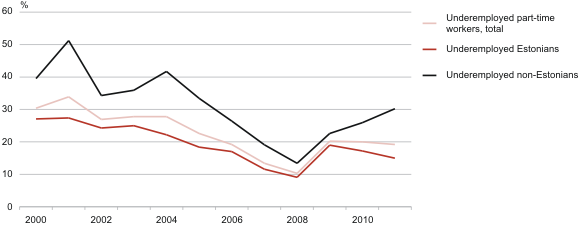One of five part-time employees wishes to work more hours
In Estonia, there were 65,000 persons working part-time in 2011 (a tenth of the persons employed). Those part-time employees who would like to and who are able to work more hours are considered to be underemployed. In 2011, among those employed part-time, 19% wished to work more hours.
During the last three years, the share of the underemployed part-time employees has remained around 20% among the total number of the part-time employees. As a general trend, the share of the underemployed has been declining during the past decade. If in 2000 there were 30% (more than 16,000) underemployed persons working part-time, then in 2008, when the impact of the economic boom could be still felt, the corresponding indicator had decreased to 10% (less than 5,000).
The risk of underemployment is higher for disadvantaged groups on the labour market. The share of part-time employees who are underemployed is higher among non-Estonians, elderly and less qualified persons. If in the European Union as an average the share of part-time employees who are underemployed is remarkably higher for men than for women, then the respective indicator for men and women is more or less equal in Estonia.
In 2011, there were 1,500 economically inactive persons seeking work, but not available to work at once, and 44,100 economically inactive persons who would wish to work but are not actively seeking work.
The share of underemployed persons among all part-time employees by ethnic nationality, 2000–2011
Three indicators supplementing the present unemployment indicators were released by Statistics Estonia in the Statistical Database. These indicators describe three groups of population, whose situation on the labour market is similar to the unemployed in several aspects, but who are not covered by the definition of the unemployed according to the International Labour Organisation (unemployed is a person who fulfils the following three conditions at the same time: 1) he or she is without work, 2) he or she is actively seeking work, 3) he or she is currently – in the course of two weeks – available to work if there should be work).
These three groups of population are the following: 1) Underemployed part-time workers; 2) Inactive persons seeking work but not immediately available; 3) Persons available to work but not seeking it (includes discouraged persons who do not believe in the chance of finding work).
The traditional labour market conception, which divides people into persons employed, unemployed and inactive on the labour market, considers the two last mentioned groups to belong to the economically inactive population (students, retired persons, homemakers, discouraged persons). At the same time they surely have certain similarities with the unemployed. These groups can be looked at as a potential labour force reserve as in certain circumstances they can most likely start working.
These indicators provide an enhanced and richer picture of the labour market, by supplementing the existing information of unemployment which is mainly based on unemployment rate. The unemployment rate is the share of the unemployed in the labour force (labour force is the sum of employed and unemployed persons among the population aged 15–74).
The estimates are based on the data of the European Labour Force Survey, which is carried out by statistical organisations in all the European Union Member States on the basis of harmonised methodology. Statistics Estonia has been conducting the Labour Force Survey since 1995 and every quarter 5,000 persons participate in it.
Eurostat will publish the news release on the 2011 supplementary indicators to unemployment of EU countries today, on 19 April, at 12:00 (GMT+3).
